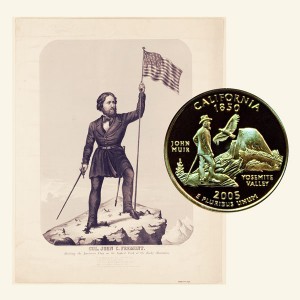Today, the California State Quarter Coin remembers the start of John C. Fremont’s first expedition to the Rocky Mountains 174 years ago.
From the Life of John Charles Fremont published in 1856:
=====
Fremont has conducted five Exploring Expeditions — the first to the Rocky Mountains, and the four subsequent ones as far as California.
He started from Washington on the first expedition commanded by himself, on the 2d day of May, 1842, under orders to explore and report upon the country between the frontiers of Missouri and the South Pass in the Rocky Mountains, and on the line of the Kansas and Great Platte Rivers.
On the 22d of May he arrived at St. Louis, and in that vicinity collected together twenty-one men, principally Creole and Canadian voyageurs, who had become familiar with prairie life in the service of the fur companies in the Indian country.
The final arrangements for the expedition were completed at Choteau’s Trading House, near the mouth of the Kansas River, about four hundred miles from St. Louis.
The guide was Christopher Carson, known for his exploits in the mountains, more familiarly as Kit Carson. This man has attained to a greater celebrity than any other of the heroic sharers in Fremont’s adventures.
Kit is a native of Kentucky, the son of one of the early hunters of that State, and is about two years older than Mr. Fremont.
A great portion of his life has been spent as a trapper and hunter among the Indians. He is a short, light, but muscular man, with mild blue eyes, an open, pleasant countenance, indicative of a naturally amiable disposition.
He is fearless, thoroughly trained to the difficulties and dangers of life in the wilderness, a dead shot with the rifle, can track an Indian as if with the scent of a hound, and in an emergency can even practice the trick of the savage with the scalping-knife.
He sticks to a steed as the skin on his back, and rides like the wind. Fremont says in his narrative that, mounted on a fine horse, without a saddle, and scouring bareheaded over the prairies, Kit was one of the finest pictures of a horseman that he had ever seen.
His first wife was a Sioux. After her death he married a native of New Mexico, where he now lives, surrounded by his family, engaged in the peaceful pursuit of farming, and also acting in the official capacity of Indian Agent for that territory.
Lieutenant Fremont first fell in with Carson on a steamboat above St. Louis, as he was starting on this expedition. He was fortunate in securing such a guide.
Before starting on this journey, Lieutenant Fremont received a marked compliment — thus soon after his marriage — from his father-in- law, who entrusted to him, under the hazardous circumstances which must attend his exploits, his only son, Randolph Benton, then a boy of twelve years.
Young Benton soon proved himself worthy of his name and blood. His first night on guard was one in which the blackness of darkness was made visible by the frequent lightning with which the whole sky seemed tremulous.
Rain poured in torrents, and the loud thunder rolled overhead. Stories of bloody Indian fights were rife in the camp. But the brave boy — with a companion of nineteen, Henry Brant of St. Louis — stood it out, and they regularly took their turn afterwards.
At Fort Laramie the hostile disposition prevailing among the Indians became so clearly developed that it was deemed prudent to leave them both. Benton, to use the language of Fremont, had been ” the life of the camp.” They were sorry to part with him.
Fremont had one man in his party who had probably received his training at the hands of some old politicians.
On the morning of June 22d, as they were proceeding up the valley of a little creek in the country of the Pawnees, this man, who was a short distance in the rear, came spurring up in great haste, shouting Indians! Indians!
He had been near enough to see and count them, according to his report, and had made out twenty-seven. They immediately halted and put their arms in order, and Kit Carson was dispatched to reconnoiter.
He soon returned with the intelligence that the Indian war party of twenty-seven, consisted of six elk, which had been gazing curiously at the caravan as it passed by and were now scampering off at full speed!
If the man who made the first report, not only more than quadrupling their number, but also converting these simple elk into savage Indians, with tomahawk and scalping-knife in hand, is still extant, he might find congenial employment, though not without powerful rivalry, in the service of the Democratic party.
…
=====
The California State Quarter Coin shows with an artist’s image of John C. Fremont placing a flag on the highest point of the Rocky Mountains.
